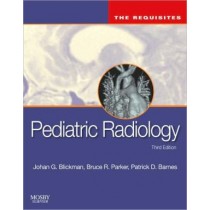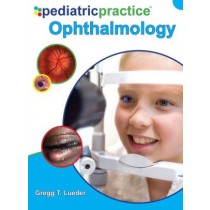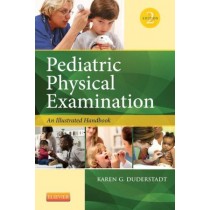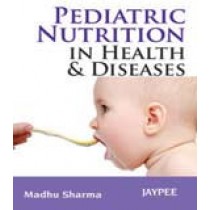Pediatrics
-

Pediatric Radiology, The Requisites, 3e
Pages: 368,
Specialties: Radiology, Pediatrics,
Publisher: Elsevier,
Publication Year: 2009,
Cover: Hardback,
Dimensions: 218.44x281.94x20.32mm
This third edition of "Pediatric Radiology" - a volume in "The Requisites in Radiology" series - covers everything from basic principles of interpreting diagnostic imaging studies through cutting-edge techniques. Expert authors Johan G. Blickman, MD, PhD and Patrick D. Barnes, MD are now joined by Bruce R. Parker, MD to provide the latest advances in pediatric radiology in a convenient, quick-access format with high-quality images. This edition features a greater emphasis on differential diagnosis, neuron functional imaging, and coverage of the dynamic topic of cardiac MR. You'll have everything you need to succeed in radiology examinations, subspecialty rotations, and clinical practice.
Weight: 1.29 KG
Learn MoreBHD39.59 -

Pediatric Radiology
Pages: 560,
Specialties: Radiology, Pediatrics,
Publisher: Oxford UP,
Publication Year: 2013,
Cover: Hardback,
Dimensions: 220.98x281.94x30.48mm
Presented in a concise and readable format, Pediatric Radiology provides a comprehensive review of 120 pathologies commonly encountered by practising radiologists and residents. As part of the Rotations in Radiology series, this volume offers a guided approach to imaging diagnosis with a constant depth of coverage, a structured template, and incorporation of applied physics, distinguishing it from other texts in the field. A definition is given for each pathology in this volume, followed by: demographics, clinical presentation, imaging modalities and features, imaging algorithm, applied physics, differential diagnoses and pitfalls, and a bulleted summary of key points. Designed for point-of-care use while training on a specific rotation, as well as for exam review and ongoing reference, Pediatric Radiology is the perfect tool to impart to residents, as well as to refresh for practitioners, the essential facts of common pathologies and the various modalities used to interpret them.
Weight: 2.06 KG
Learn MoreBHD58.81 -

Pediatric Practice Ophthalmology
Pages: 400,
Specialty: Pediatrics,
Publisher: McGraw-Hill,
Publication Year: 2011,
Cover: Hardback,
Dimensions: 218.44x276.86x22.86mm
Hands-on, full-color guidance for treating ophthalmic diseases in children 600 full-color clinical images and illustrations "This is a hybrid between a textbook and a clinical guide that aims to bridge the knowledge gap between general pediatric practitioners and specialized pediatric ophthalmologists in the care of children with eye disease. It is organized in an easy-to-use fashion with numerous pictures and clinical algorithms to make it useful for everyday use. 3 Stars."--Doody's Review Service Part of the Pediatric Practice series, Pediatric Practice: Ophthalmology is filled with practical, clinically relevant guidance on the successful diagnosis and management of children with ophthalmic symptoms and diseases. The care of the patient forms the core of this book, which also provides perspectives on epidemiology, pathophysiology, and diagnosis that every pediatrician, pediatric resident, and nurse should be familiar with. Over 600 full-color clinical images and illustrations highlight the techniques, diseases, and disorders discussed throughout the book. The book is logically divided into three parts: the first section describes the examination techniques, instruments, and ancillary tests used for evaluation of pediatric eye disorders. The second section on symptoms provides a straightforward how-to approach based on specific clinical presentations allowing pediatricians to quickly evaluate and accurately diagnose a patient in the office. The third section on diseases follows the style of traditional medical textbooks, offering greater detail on treatment of disease while maintaining the book's easy-to-absorb presentation.
Weight: 0.91 KG
Learn MoreBHD34.31 -

Pediatric Practice Infectious Diseases
Pages: 808,
Specialty: Pediatrics,
Publisher: McGraw-Hill,
Publication Year: 2009,
Cover: Paperback,
Dimensions: 222x276x36mm
The most practice-oriented guide to diagnosing and managing infectious diseases in children "...will serve as a valuable resource for medical students, residents, pediatricians, family physicians, emergency department physicians, pediatric nurses, and pediatric infectious disease specialists...I will put it in my library where I practice and will use it especially when I am looking for an algorithm for diagnosis or treatment or seeking photographs or illustrations of a specific disease. I will use other sections for teaching hospital residents about specific infections. It is reasonably priced and covers a large amount of clinical care applicable to adults and children."--JAMA Part of the Pediatric Practice series, Pediatric Practice: Infectious Diseases is filled with practical, clinically relevant guidance for successful infectious disease management. The care of the patient forms the core of this indispensable resource, which also provides perspectives on epidemiology, pathophysiology, and diagnosis that every pediatrician, infectious disease specialist, and pediatric nurse needs to know. The book's high-yield coverage includes detailed, yet precise overviews of specific infections and their etiology, along with proven diagnostic and management strategies that you can incorporate into your practice right away. Features: Tips that tell you what you must know--and what you must do--at every stage of care Diagnostic and treatment algorithms Signs/Symptoms and Differential Diagnosis boxes "When to Refer" boxes, which examine all the relevant clinical considerations Diagnostic Tests--with a realistic emphasis on the rights tests to order Medical Treatment coverage that includes drugs, dosages, and administration in an easy-to-read tabular format Convenient icons and a templated chapter design Numerous clinical color photos and didactic diagrams
Weight: 1.86 KG
Learn MoreBHD32.42 -

Pediatric Practice Gastroenterology
Pages: 480,
Specialty: Pediatrics,
Publisher: McGraw-Hill,
Publication Year: 2010,
Cover: Hardback,
Dimensions: 223.52x284.48x22.1mm
Complete how-to guidance on managing gastrointestinal diseases and disorders in children In full color! "Pediatric Practice: Gastroenterology is a beautifully illustrated and reader-friendly textbook that provides a well-rounded overview of pediatric gastroenterology that provides an excellent resource for general pediatricians and allied health professionals caring for children in general practice."--Gastroenterology Part of the Pediatric Practice series, Pediatric Practice: Gastroenterology is a unique source of clinically relevant information on the diagnosis and treatment of children with gastrointestinal symptoms and disorders. The care of the patient forms the core of this full-color resource, which also provides perspectives on epidemiology, pathophysiology, and diagnosis that every pediatrician, pediatric resident, gastroenterologist, and pediatric nurse needs to know. Expert authors in each subject area provide detailed, yet concise overviews of important disorders of the esophagus, stomach, intestine, pancreas, and liver. You will also find discussion of common symptoms, their differential diagnosis, and how they should be evaluated and treated along with an introduction to the use of diagnostic modalities such as radiology, nuclear medicine, and endoscopy. A listing of relevant, recent articles appears at the end of each chapter allowing you to expand your exploration of a given topic. The Pediatric Practice series simplifies the care of pediatric patients by delivering: Tips that tell you what you must know--and what you must do--at every stage of care Diagnostic and treatment algorithms Signs/Symptoms and Differential Diagnosis boxes "When to Refer" boxes, which examine all the relevant clinical considerations Diagnostic Tests--with a realistic emphasis on the right tests to order Medical Treatment coverage that includes drugs, dosages, and administration in an easy-to-read tabular format Convenient icons and a templated chapter design Numerous clinical color photos and didactic diagrams Logical section organization, with consistent headings among chapters covering similar topics Introductory sections that provide an update on recent research that informs clinical practice Full-color throughout
Weight: 1.21 KG
Learn More -

Pediatric Physical Examination, An Illustrated Handbook, 3rd Edition
Pages: 386,
Specialty: Pediatrics,
Publisher: Elsevier,
Publication Year: 2018,
Cover: Spiral bound,
Dimensions: 152x229x19.05mm
Known for its accuracy, consistency, and portability, Pediatric Physical Examination: An Illustrated Handbook, 3rd Edition teaches the unique range of skills needed to assess children of all ages. Spiral-bound for quick reference in clinical settings, this photo-rich, step-by-step guide to physical examination for advanced practice providers prepares you to expertly examine children from birth through adolescence. Body system chapters begin with fetal development and take you through the key developmental stages of childhood. For infants and young children, Duderstadt uses the quiet-to-active approach favored by pediatric experts and considered more effective for this age-group than the traditional head-to-toe approach used for adults. This edition features a new chapter on newborn physical examination, expanded coverage of skin conditions and new Red Flag highlights that help you recognize high-priority health issues. Expert guidance for the pediatric exam employs the quiet-to-active approach to the examination and assessment of infants - including preterm infants - and young children. This pediatric assessment approach, which starts with listening and moves on to touching, yields the best results in this age group. Richly illustrated in full color to help facilitate learning, with more than 300 photos and drawings that familiarize you with assessment techniques and common assessment findings. Easy-to-use two-column format provides quick access to concise guidance for the pediatric physical exam. Quick-reference special features, including: Information Gathering tables highlight questions and data needed from the patient/guardian, with questions conveniently separated by age group, to guide history-taking. Concise Conditions tables summarize common abnormal findings for each examination area. Pediatric Pearls highlight effective physical examination findings and techniques gleaned from years of expert practice. Family, Cultural, and Racial Considerations sections address the increasingly important areas of family and cultural assessment to prepare you for differences to anticipate when assessing children of various cultural or racial groups. Evidence-Based Practice Tips highlight useful research findings that guide clinical practice. Bulleted Summary of Examination lists at the end of each examination chapter highlight key assessment points associated with each body system and serve as a convenient learning aid and quick reference. End-of-chapter Charting examples demonstrate how to record physical examination findings in the health record and familiarize you with documentation language and format. Convenient spiral binding lets you lay the book flat or fold it back for easy visualization and quick reference in clinical settings. NEW! Completely new Newborn Assessment chapter equips you to provide comprehensive assessment of newborn patients. UPDATED! Expanded coverage of skin conditions equips you to effectively assess the common pediatric skin conditions that you will encounter in day-to-day practice. NEW and UNIQUE! Red Flag feature alerts you to recognize such issues as trauma, neglect, health issues related to conflict-related geographic displacement, and other high-priority health issues that practitioners encounter (e.g., croup, developmental delay). UNIQUE! Interprofessional Collaboration feature promotes engagement with other healthcare and non-healthcare professionals, such as Occupational Therapists, Physical Therapists, physicians, medical specialists, counselors, or other professional resources. NEW! Updated content throughout, including the latest coverage of gender considerations, autism spectrum disorder screening, and electronic documentation (charting via the EHR). show more
Weight: 0.57 KG
Learn MoreBHD26.01 -

Pediatric Physical Examination, An Illustrated Handbook, 2e
Pages: 376,
Specialty: Pediatrics,
Publisher: Elsevier,
Publication Year: 2013,
Cover: Spiral bound,
Dimensions: 162.56x228.6x15.24mm
This portable, photo-rich guide to physical examination for Nurse Practitioners and other primary care providers will help you develop the unique range of skills required to assess children of all ages. System chapters begin with embryological development and review the key developmental stages of childhood. For infants and young children, this step-by-step guide uses the "quiet-to-active" approach favored by pediatric experts and considered more effective for this age-group than the traditional head-to-toe approach used for adults. Other key topics include pediatric mental health assessment and growth and development screening and surveillance. "This handbook serves more than its obligatory purpose by inserting the relevant additional information about basic information. Addressing the needs of the parent while caring for the child has been given due importance.Various examination techniques have been very well explained and beautifully illustrated. This handbook serves the needs of undergraduate medical students ,nursing students and is good refresher for Pediatric post graduates." Reviewed by: Neel Kamal, Date: Aug. 14
Weight: 0.54 KG
Learn MoreBHD24.51 -

-

-

Pediatric Neuroimaging, 6E
Pages: 1298,
Specialties: Pediatrics, Radiology,
Publisher: Wolters Kluwer,
Publication Year: 2019,
Cover: Hardback,
Dimensions: 213x276x53.34mm
This newest addition of the comprehensive Pediatric Neuroimaging combines thousands of images with detailed textual descriptions to help you diagnose a wide range of brain, spinal, and head and neck disorders in the pediatric patient. The authors have chosen a clear, concise writing style that encourages you to grasp information quickly. By dealing with a broad range of disorders, from everyday problems to less common ones, and explaining how to recognize and differentiate them, this book offers you the opportunity to provide a concise differential diagnosis on most patients you are likely to encounter in your practice. Packed with more than 2,500 high-quality illustrations, drawings, photographs, and figures. Emphasizes CT and MRI imagery-widely regarded as the optimal modalities for assessing and diagnosing children. Most chapters organized by disease group, and describe the pathologic bases of each disorder to illustrate important clinical contexts. Broadly discusses common imaging techniques in children, as well as images of normal childhood development in the brain, skull, and spine. Prominently displayed lists of disorders help quickly identify a disorder within the text. Enrich Your eBook Reading Experience with Enhanced Video, Audio and Interactive Capabilities! Read directly on your preferred device(s ), such as computer, tablet, or smartphone Easily convert to audiobook , powering your content with natural language text-to-speech Adapt for unique reading needs , supporting learning disabilities, visual/auditory impairments, second-language or literacy challenges, and more show more
Weight: 3.74 KG
Learn More



